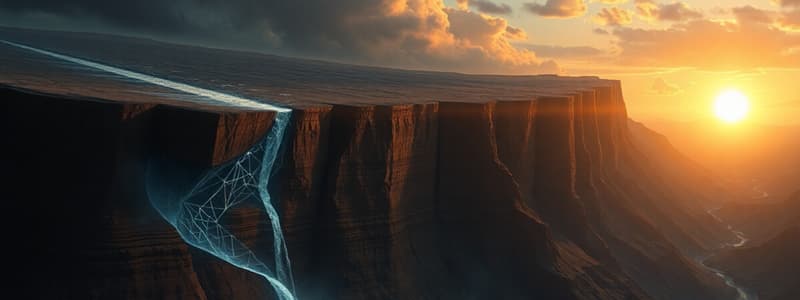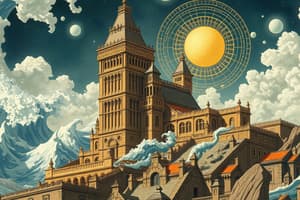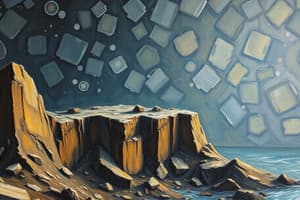Podcast
Questions and Answers
What type of stress is primarily associated with convergent plate boundaries?
What type of stress is primarily associated with convergent plate boundaries?
- Compression stress (correct)
- Confining stress
- Tension stress
- Shear stress
Which type of stress causes rocks to lengthen or break apart?
Which type of stress causes rocks to lengthen or break apart?
- Tension (correct)
- Shear
- Compression
- Confining
What is the term for the stress when forces are parallel and moving in opposite directions?
What is the term for the stress when forces are parallel and moving in opposite directions?
- Tension
- Elastic
- Shear (correct)
- Compression
Which factor increases pressure on deeply buried rocks?
Which factor increases pressure on deeply buried rocks?
What happens to rocks during elastic deformation?
What happens to rocks during elastic deformation?
What magnitude of earthquake is often felt but typically causes minor damage?
What magnitude of earthquake is often felt but typically causes minor damage?
Which level on the Richter scale corresponds with considerable damage to specially built structures?
Which level on the Richter scale corresponds with considerable damage to specially built structures?
What is the expected effect of an earthquake with a magnitude of 6.1 to 6.9?
What is the expected effect of an earthquake with a magnitude of 6.1 to 6.9?
Which geological process is primarily caused by earthquakes and volcano eruptions?
Which geological process is primarily caused by earthquakes and volcano eruptions?
How frequently do great earthquakes (magnitude 8.0 or greater) occur?
How frequently do great earthquakes (magnitude 8.0 or greater) occur?
At what magnitude does an earthquake start to typically cause slight damage to buildings and other structures?
At what magnitude does an earthquake start to typically cause slight damage to buildings and other structures?
What is a primary effect of a magnitude 7 earthquake according to the scale described?
What is a primary effect of a magnitude 7 earthquake according to the scale described?
Which level on the Richter scale indicates total damage with few, if any, structures remaining standing?
Which level on the Richter scale indicates total damage with few, if any, structures remaining standing?
What is the key characteristic of a regional tsunami?
What is the key characteristic of a regional tsunami?
What distinguishes a distant tsunami from other types of tsunamis?
What distinguishes a distant tsunami from other types of tsunamis?
Which of the following is NOT a primary way earthquakes can lead to fires?
Which of the following is NOT a primary way earthquakes can lead to fires?
Which measure is essential for reducing the risk of fires caused by earthquakes?
Which measure is essential for reducing the risk of fires caused by earthquakes?
What mechanism can cause flooding as a result of an earthquake?
What mechanism can cause flooding as a result of an earthquake?
Which of the following is a recommended practice for managing wildfire risks in earthquake-prone areas?
Which of the following is a recommended practice for managing wildfire risks in earthquake-prone areas?
Which factor is critical when developing emergency response plans for earthquakes?
Which factor is critical when developing emergency response plans for earthquakes?
What is NOT a form of earthquake-resistant construction practice?
What is NOT a form of earthquake-resistant construction practice?
Flashcards
Earthquake Mechanism
Earthquake Mechanism
The process of ground shaking caused by vibrations in structures connected to the ground
Compression Stress
Compression Stress
Squeezes rocks together, leading to folding or breakage.
Tension/Extensional Stress
Tension/Extensional Stress
Pulls rocks apart, causing them to lengthen or break.
Shear Stress
Shear Stress
Signup and view all the flashcards
Confining Stress
Confining Stress
Signup and view all the flashcards
Earthquake Magnitude
Earthquake Magnitude
Signup and view all the flashcards
Richter Scale
Richter Scale
Signup and view all the flashcards
Earthquake Effects (Magnitude 2.5 or less)
Earthquake Effects (Magnitude 2.5 or less)
Signup and view all the flashcards
Earthquake Effects (Magnitude 2.5-5.4)
Earthquake Effects (Magnitude 2.5-5.4)
Signup and view all the flashcards
Earthquake Intensity
Earthquake Intensity
Signup and view all the flashcards
Magnitude 5.5-6.0 Earthquake
Magnitude 5.5-6.0 Earthquake
Signup and view all the flashcards
Landslides and Earthquakes
Landslides and Earthquakes
Signup and view all the flashcards
Earthquake Magnitude Scale
Earthquake Magnitude Scale
Signup and view all the flashcards
Regional Tsunami
Regional Tsunami
Signup and view all the flashcards
Distant Tsunami
Distant Tsunami
Signup and view all the flashcards
Earthquake-Related Fires
Earthquake-Related Fires
Signup and view all the flashcards
Building Codes for Earthquake Resilience
Building Codes for Earthquake Resilience
Signup and view all the flashcards
Earthquake Preparedness Measures
Earthquake Preparedness Measures
Signup and view all the flashcards
Earthquake-Related Flood
Earthquake-Related Flood
Signup and view all the flashcards
Liquefaction
Liquefaction
Signup and view all the flashcards
Vegetation Management
Vegetation Management
Signup and view all the flashcards
Study Notes
Earthquake Mechanism
- Earthquakes are ground shaking resulting from structures connected to the ground vibrating
- Ground motion, structural vibration, and building destruction are detailed processes in earthquakes (Celebi and Brown, 1994)
Stress and Forces in Earth's Crust
- Enormous lithosphere slabs move unevenly, causing earthquakes
- The Earth's brittle outer layer is under constant stress
- Stress is the force per unit area applied to a rock
- Four stress types act on materials:
- Compression: Rocks are squeezed together; common at convergent plate boundaries
- Tension/Extensional: Rocks are pulled apart; common at divergent plate boundaries
- Shear: Forces are parallel but move in opposite directions; common at transform plate boundaries
- Confining stress: Deeply buried rocks are pushed down by the weight of material above; cannot deform
Rock's Response to Stress
- Elastic Deformation: Rock returns to its original shape after stress is removed; reversible and not permanent
- Plastic Deformation/Ductile Deformation: Rock does not return to its original shape; irreversible and permanent
- Brittle Fracture: Rock breaks
Types of Folds
- Compressive stresses cause rocks to crumple into folds
- Rocks do not return to their original shape after deformation
- Monocline: Simple bend in rock layers; no longer horizontal
- Anticline: Upward-arched fold; oldest rocks at the center
- Syncline: Downward-bending fold; youngest rocks at the center
Types of Earthquakes
- Earthquakes vary in their behavior
- Earthquakes are sudden energy releases in the Earth's crust or upper mantle
- Seismicity is the earthquake frequency, type, and size experienced over time
- Moment magnitude is the most used scale for measuring earthquakes globally, primarily for those above magnitude 5
Seismic Waves
- Seismic waves are vibrations traveling through the Earth's interior or along its surface
- Body Waves: Travel through the Earth's interior
- Primary (P) waves: Fastest; move through solids, liquids, or gases: Compressional
- Secondary (S) waves: Slower; move only through solids: Transverse
- Surface Waves: Travel along the Earth's surface
- Love waves: Transverse motion, horizontal; most destructive to structures
- Rayleigh waves: Complex motion; up-and-down, and forward-backward; most felt during earthquakes
Tectonic Earthquakes
- Explained by elastic rebound theory
- Generated when strains in rock masses have accumulated and can't withstand the stresses
- Caused by the sudden fracturing of rock masses
- Example: San Andreas Fault (ruptured in 1906)
Motions of Plate Tectonics During Earthquakes
- Divergent Boundaries: Two plates move away from each other (e.g. Great Rift Valley in Africa, the Red Sea and the Gulf of Aden)
- Convergent Boundaries: Two plates move towards each other
- Continental-Oceanic: Oceanic plates sink (subduction); create trenches and volcanoes
- Oceanic-Oceanic: One oceanic plate sinks under another, forming volcanoes
- Continental-Continental: Both plates are strong, causing collisions and mountain formation
- Transform Boundaries: Two plates slide past each other (e.g., San Andreas Fault)
Volcanic Earthquakes
- Related to volcanic activity
- Types:
- Volcano-tectonic: Caused by stress changes in solid rock due to magma.
- Long-period: Related to the unsteady transport of magma.
Explosion Earthquakes
- Caused by nuclear or chemical explosions.
Collapse Earthquakes
- Occur due to landslides or material collapsing below the Earth's surface.
- Can result from massive rock movement, steep slopes, heavy rainfall.
Earthquake Magnitude
- Measure of an earthquake's size.
- Proportional to the amount of released seismic energy
- Seismometer data is used to determine the earthquake characteristics (e.g., location, magnitude, time).
- Modern systems precisely amplify and record ground motion over 0.1 to 100 seconds.
Earthquake Intensity
- Measure of shaking and damage caused by an earthquake
- Varies by location
- Many intensity values are distributed around the epicenter
Earthquake Destruction
- Structural damage to buildings
- Injuries and casualties
- Costs
- Psychological effects
- Environmental impacts
Tsunamis
- Caused by earthquakes, landslides, or volcanic eruptions
- Powerful ocean waves generated
- Types: Local, Regional, Distant/Tele
Liquefaction
- Phenomenon where saturated soil temporarily loses strength during earthquakes
- Causes instability, damage to structures, and economic problems
- Happens when excess pore water pressure from cyclic loads weaken the soil.
Fires
- Secondary effect of seismic events; not directly from shaking itself
- Causes: ruptured gas lines, electrical faults, collapsed structures, ignition from friction
- Widespread and difficult to control
Floods
- Earthquakes can indirectly lead to floods through several mechanisms:
- Dam failures
- Landslides
- Debris flows
- Ground rupture effects on rivers
Studying That Suits You
Use AI to generate personalized quizzes and flashcards to suit your learning preferences.




